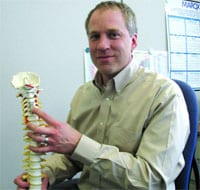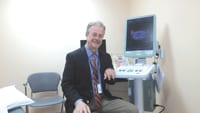Instruments of Progress Marox Corp. Brings Surgical Precision to Medical Manufacturing
Brad Rosenkranz keeps a model of the human spine in a corner of his office at Marox Corp. in Holyoke. If nothing else, it’s the best way to demonstrate exactly what the manufacturer’s products do.
At one point, he held a cervical plate, formed from titanium, to the front of the spine, showing how it provides stability in the neck area when it’s used by surgeons in the treatment of traumas or degenerative spine conditions.
He also produced a few titanium pedicle screws, which hold in place the rods used to repair and connect the vertebrae; and talked about an organic polymer thermoplastic called PEEK, a lightweight, biocompatible substance used as a spacer between vertebrae. It’s radiolucent, meaning X-rays can pass through it, which is a benefit to doctors.
“Surgeons like it because they can see,” said Rosenkranz, Marox’s vice president of sales and marketing. “There are usually three titanium markers we assemble into PEEK, and on an X-ray they show up as three dots, showing surgeons how the implant is positioned.”
Other Marox products include spinal hooks, components for the hip and knee joints, and even some dental products and small parts for endoscopes, all of which contribute to the 59-year-old company’s reputation among the region’s leading manufacturers of medical implants.
Marox’s customers are OEMs, or original equipment manufacturers, which supply medical practitioners with surgical and other types of devices. “We work with large OEMs, medium-size OEMs, we even work with startups — the whole spectrum,” said Rosenkranz.
“With spines, the industry has come out with more and more products that are vastly improved,” he noted. “The spine was a grossly underserved market, but now a lot of companies are entering the field, trying to take on the big spine companies, and now I think the industry has become saturated with OEMs.”
Meanwhile, he said, the U.S. Food and Drug Administration has become more stringent about approving new medical devices, particularly for technology that is similar to anything already on the market. “It’s difficult,” he said of the increased competition to design products. “But it’s pretty good for patients now.”
Testing Their Metal
When Manfred Rosenkranz and his three sons acquired Marox in 1988, it manufactured a variety of items, ranging from small-arms components for Colt and Smith & Wesson to commercial hardware products.
Soon thereafter, Marox started becoming heavily involved in the aerospace industry. Meanwhile, its production of an angioplasty product became its entry into medical manufacturing. One of those niches would not survive.
“After years of seeing volatility taking place in aerospace,” Brad Rosenkranz said, “and having more and more opportunities presented with medical implants, we realized that, in order to capitalize on the opportunities in medical, we had to phase out all other industries, including aerospace. And the growth in the spinal-implant market worked out very well for us; we rode that wave.”
He stressed that Marox isn’t a design firm, but does contribute in some ways to the design process — specifically, taking the design a customer has developed and providing input on manufacturability.
“We might say, ‘if you change this component here, it will make it a lot easier to produce.’ They’ll say, ‘yes, we can make that change,’ or ‘no, we can’t; that’s a critical dimension.’ Ultimately, with our feedback and theirs, we agree on a design that works for them, that meets their needs and also meets our production needs.”
Rosenkranz explained that the medical-machining industry is in many ways beholden to regulatory decisions. For example, a technology known as motion preservation, which allows joints to fully articulate instead of being fused together, wasn’t being covered by public payers, and the momentum of development in that area slowed down as a result. It’s now being overtaken by something known as dynamic stabilization.
“It looks like the industry is moving more toward dynamic stabilization,” he said, explaining that the technique connects two sections of the spine and reduces the prevalence of adjacent level disease, which is a pathology that develops in a vertebra adjacent to a fused bone.
“Dynamic stabilization allows some movement — not a lot, but a little bit,” he explained. “Kind of like a shock absorber, it allows the rod to bend and move, and allows adjacent bones a little movement. It’s better for bones to have that flexibility and movement because, if you don’t have that, you tend to have some negative effects. This dynamic stabilization creates the movement the bone needs and helps a lot with adjacent level disease.”
Rosenkranz said it’s tough to predict where the next breakthroughs will come, a forecast partly clouded by uncertainty surrounding health care reform and how any change in the health care system will impact peripheral industries, like medical manufacturing.
“Nobody really knows, with the current administration, where this is all going to end up,” he said, adding that he expects innovation to continue whatever the structure of health care. “This is a very progressive industry, and they’ve come a long way in terms of technology.”
However, while components and tools for spinal surgery have consistently become more sophisticated over the years, he added, some products have stayed relatively unchanged over the past decade — notably certain components for major joint replacements — simply because they do their job so effectively.
“The designs on hips and knees haven’t changed too much over the years,” he noted. “They work really well, so it’s the ‘if it ain’t broke, don’t fix it’ type of thing.”
Room to Grow
Marox — with its emphasis on lean, efficient manufacturing and its pristine facility — is, like many modern plants, a far cry from the old stereotype of the dirty, chaotic factory floor.
But not everyone knows that, Rosenkranz said, and it’s a challenge to make sure people understand what today’s manufacturing floor is like, and to raise the prestige of what are often very high-tech jobs — which is why he conducts tours of the facility for trade-school students.
“We want to show kids that, hey, there is something to manufacturing,” he said. “I think it may have gotten a bad rap, that it’s not glamorous, and people have jumped to computers, software, and IT because they’re the glamour jobs, and manufacturing got left in the dust.
“But we’re showing kids that this is high-tech, precision work, making really sophisticated components — and, on top of that, for a good cause,” he continued. “Some people hear ‘manufacturing’ and think of a dirty foundry, a dark, gloomy, grungy place. But it is very clean and high-tech. We’ve been told our facility is reminiscent of a European facility, with lab coats, where everything is clean and neat.”
Rosenkranz is excited not only about the work that Marox performs, but for the whole umbrella of burgeoning bioscience applications, from synthetic bones and stem-cell products to bone-growth stimulators and other technologies that fall outside Marox’s metal-machining specialty.
Economic-development experts have long pegged Massachusetts as a hotbed for such cutting-edge industries, and Rosenkranz doesn’t doubt that this region could be a growth sector, at least for high-tech precision machining.
“I think there’s good talent here in Western Mass.,” he said. “Finding skilled workers is a problem that everyone faces nationally, but here in Western Mass., I think we’re just as well-off if not better-off than anyone else in terms of a skilled workforce. Around here we have a lot of manufacturing, and a lot of colleges having more awareness in terms of what’s available in manufacturing.
“We’ve seen a lot of growth over the past several years,” he added, “and it looks to be so in the future as well. It’s a great industry to be in.”
For anyone, that is, with the spine to take on some high-tech challenges.


